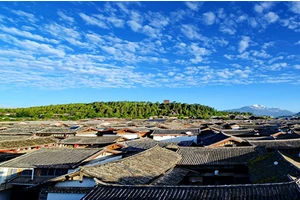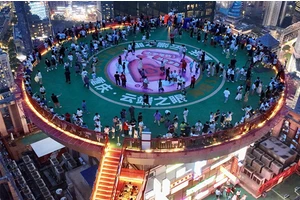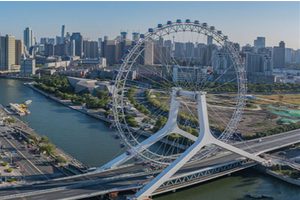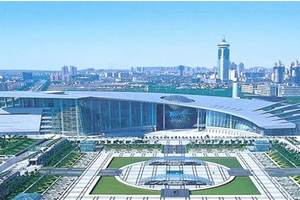Ctrip Travel Xi 'an
The traffic in Xi 'an is very developed, and all kinds of traffic routes from the whole country and even the whole world go directly to Xi 'an (except navigation).
A. Friends who arrive in Xi 'an by plane can contact taxi first after getting off the bus (drivers usually stand at the exit). From Xianyang Airport to downtown Xi 'an, the price of taxi is 120-90 yuan, mainly depending on your bargaining power. If you aim at a PPMM on the plane, you can also share a car with several people, which saves a lot. Besides taxi, there is the airport bus, which is just outside the exit, and 25 yuan reaches the downtown area. Very convenient.
B: It's much more convenient for friends who take the train. There are dozens of bus lines to the urban area at Shangdemen (the north exit of Jiefang Road) outside the railway station. Here are some key lines:
611 Road (the well-deserved first bus line in Xi 'an): the railway station-Daqing Road, passing through the whole section of Jiefang Road (the top ten department stores in China, Minsheng Department Store, are on this road)-Dacha City (Hyatt Hotel is here, Clinton lived here when he came, and this section was all under martial law at that time)-East Street (one of the most famous bustling commercial districts in China, the gate of Tang Palace is here, and it is time for now. Xi 'an's administrative divisions and urban functional divisions are bounded by this, and there are many places worth going around, which will be introduced in detail later. Don't go away.)-West Street (back to the ethnic gathering place, there are many old streets and old houses and flavor snacks in Xi 'an)-West Gate (Anyuanmen, which is Yuxiang Gate to the north, and General Feng Yuxiang entered Xi 'an from time to time)-Xiguan-Tumen (a novel by Mr. Jia Pingwa)
No.603, the second bus line in Xi 'an. Railway Station-Shaanxi TV Tower, passing Jiefang Road-Dongxinjie along the way (Dongxinjie is the largest open-air night market in China from 1980s to the end of 1990s, with more than 400 merchants at most, gathering snacks from Xi 'an and the whole country, usually from 6pm to 4am. However, in order to improve the urban environment, the Xi 'an municipal government banned this night market several years ago, and turned to indoor. Although it is not as large as before, it is still an excellent place to eat night markets. Later)-Xincheng Square (the seat of the provincial government, which was called Imperial Square before liberation, was the center of the Tang Palace. After the founding of the People's Republic of China, it was changed to Xincheng Square. During the Republic of China, Jiang Jieshi used to work here, which contained the famous Yellow House)-Xihuamen-Bell Tower-South Street (the youngest and most prosperous commercial district in Xi 'an, where many shops can be found)-South Gate (An) )-Nanshaomen-Stadium (also known as Suzaku Square in Shaanxi Province, the home of Shaanxi National Team)-Conservatory of Music-Xiaozhai (the second center of Xi 'an, which is full of vitality and modernity because of the surrounding universities)-Foreign Languages Institute-Shaanxi Normal University-TV Tower
No.5 Road, Railway Station-Cancer Hospital, passes through the whole section of Jiefang Road-Heping Road-Hepingmen-Yanta Road (Yanta Road is an electronic street in Xi 'an, similar to Zhongguancun in Beijing, five northwestern provinces and even the whole western electronic information distribution center). -Big Wild Goose Pagoda (where Master Xuanzang translated Buddhist scriptures, and Qujiang New District, which has been newly established here, contains many landscapes such as the Tang Dynasty, which will be the highlight of the new city in Xi 'an in the future)-Xiaozhai East Road-Xiaozhai-Ziwu Road-Cancer Hospital (there is also Xi 'an Academy of Fine Arts, and the famous painter Liu Wenxi is the dean here).
No.14 Railway Station-Maple Leaf New City passes through Railway Station-Jiefang Road-Heping Road-Hepingmen-Huancheng South Road-Wenyi Road (this road brings together major literary and art groups in Xi 'an, including Shaanxi Song and Dance Theatre, Shaanxi Repertory Theatre, Xi 'an Art School, Xi 'an Mass Art Museum, Beijing Opera Troupe, Shaanxi Opera Troupe and famous composer Zhao Jiping. Famous performance artists Guo Da and Li Qi all went to the whole country from here)-Nanshaomen-Stadium-Xiaozhai-Xiaozhai West Road-Ziwu Road-Taibai Road-Xi 'an High-tech Zone (a national high-tech industrial demonstration zone, with Xi 'an Electronic City nearby, Xi 'an has a western suburb industrial city, a southern suburb cultural and educational city and an electronic city, an eastern suburb textile city, a northern suburb airplane city and an agricultural development city)-Maple Leaf New City.
Road 103 passes through the northwest small commodity distribution center, and there are more than 100 large and small wholesale cities on this road, but the traffic here is not very good. There are many people in the car.
No.9 road goes to the northern suburbs via Xiwu Road.
602 Railway Station-Weishi Street passes Jiefang Road-Dacha City-Dongmen (Changle Gate)-Dongguan Main Street-Xingqing Road (named after Xingqing AD nearby, Xingqing Palace is a royal garden of Tang Dynasty with Xingqing Lake, which is a good place for Xi 'an citizens to relax. It is strongly recommended to visit. )-Xi 'an Jiaotong University-Jinhua Road-East High-tech (the development of high-tech industries in Xi 'an is divided into east and west parts)-Jinger Road-Weishi Street (this place is absolutely important, and the famous Xi 'an Satellite Measurement and Control Center is here, from which all rocket satellites launched by our country are measured and controlled).
No.306 special tourist line, traveling to Xi 'an East Line, Banpo Museum, Qin Shihuang Mausoleum, Terracotta Warriors, Huaqing Pool, Mount Li, Lintong Museum, Hongmen Banquet Site and Bian Que Tomb.
There are a number of other large and small routes running to urban areas and various tourist attractions, so I won't go into details here.
C. Highway-Xi 'an is located in the central and western part of China. Driving to Xi 'an from Shanxi, Henan, Hebei, Beijing, Tianjin, and the three eastern provinces can pass through Shijiazhuang first, then Taiyuan, take the Dayun Expressway, turn to fenglingdu, enter Qindong of Shaanxi, connect with Xitong Expressway, and directly reach Xi 'an. You can also take Huolian Expressway from Shijiazhuang to Zhengzhou to Tongguan and transfer to Xitong Expressway.
You can go to Zhengzhou from Shandong first. From Jiangsu, Shanghai and Zhejiang, you can transfer to Xuzhou, Huolian Expressway, Tongguan and then Xi 'an. From central and southern Hubei, Hunan, Guangxi, Guangzhou, you can go to Ankang through Shiyan, Hubei, and then jump over Qinling to Xi' an through Lantian. Southwest provinces can cross the Qinling Mountains from Chongqing to Hanzhong to Xi 'an.
After entering Xi 'an, there are 80 kilometers of expressway, and you can reach all parts of Xi 'an according to the road signs.
After arriving in Xi 'an, I began to look for a place to live. There are hotels, foreign-related hotels, hotels, hotels and hostels of various grades in the city, which can be selected according to needs.
High-end hotels: Shangri-La Golden Flower Hotel (shangelila), Hyatt Afang Palace Hotel (hayyat), Sheraton Hotel (sharaton), Castle Hotel (ANA), Imperial City Hotel, howord johnson Queen Hotel, Oriental Hotel, Tang Hua Hotel, Qujiang Hotel, Xi 'an Hotel, Shaanxi Hotel, Bell Tower Hotel and so on. In addition to these, there are many Samsung hotels in Xi 'an, all of which are large in scale and grade, clean and tidy, and thoughtful in service. Of course, there are even worse hotels if you want to save money. But the service and environmental quality will also decline.
There are many hotels in other grades, so I won't go into details here.
Now that we have settled in Xi 'an, we will go on our way after a rest.
I. Tourist routes:
Let's start with the central city of Xi 'an.
1. The Bell Tower, the center of the city, was built in the Ming Dynasty, initially 2 kilometers west, and then moved to its present position as a whole. It can be accessed from the underground track of the bell tower. From the bell tower, you can overlook the four streets in Xi 'an, and the effect is unusual. And the clock on the bell tower is the most famous. Why? According to the old people, the whole city of Xi 'an can hear any clock that the old Xi 'an knocks on the bell tower! Presumably you have to knock when you come to Xi 'an.
2. The Drum Tower, which is far away from the bell tower, is the so-called morning bell and dusk drum, and there is the North Courtyard Gate (Huimin Street) food street.
3. Ming City Wall, the most complete ancient military defense facility in the world. So far, it has experienced more than 600 years of wind and rain, and it is still a symbol of Xi' an city.
4. The forest of steles, known as the gathering place of calligraphy in China, has collected more than 10,000 calligraphy inscriptions of celebrities in past dynasties, and is also known as the China Calligraphy Inscription Museum. Located in Wenchang Men Site, south of the city wall.
5. The Eighth Route Army Office, as the name suggests. Xiqi Road, located within the city wall.
6. Big Wild Goose Pagoda and Jionji, where Master Xuanzang translated Buddhist scriptures. Located at the south end of Yanta Road. Big Wild Goose Pagoda North Square. There is one of the best music fountains in Asia. It's not just water spray+music. The spouted water will change with the music, and the momentum is really spectacular. Now you can't go to Xi 'an without seeing it. I suggest going at night, because it will have the effect of colored lights and look better.
7. Shuyuanmen Street is located in the south gate, where there are antique calligraphy and paintings and antiques are sold. And Guanzhong Academy.
8. Little Wild Goose Pagoda and Jianfu Temple are located at the intersection of Youyi West Road and Zhuque Road.
9. Grand Mosque, located in Huajue Lane, North Yard Gate.
10. Banpo Museum is a village of Banpo people nearly 6000 years ago. Located in the eastern suburb of Xi 'an, Banpo Road.
11. Shaanxi History Museum, an absolute heavyweight museum. A collection of cultural relics unearthed in Shaanxi for many years.
II. The Western Front
1. Xianyang Museum: Xianyang is the birthplace of Qin culture.
2. Mausoleum, Ganling, Zhaoling, Tomb of Yang Guifei, Tomb of Tang Dynasty. Huoqubing Tomb
3. Famen Temple Buddha refers to the storage place of relics, a famous Buddhist resort in China. Located in Fufeng County.
4. Taibai Mountain is located in meishan county, Baoji City. Arrival performance of ecological virgin forest in Qinling Mountains. There are hot springs, called Xitang Bath and Lantian Dongtang Bath. Quaternary glaciers, rare birds, and Taibai snow (there will be a hundred snows on the mountain in June, and it is strongly recommended to play. )
5. The source of Jialing River in Baoji, everyone knows that Jialing River is in Chongqing, but its source is in Shaanxi. The water at the source is crystal clear and the scenery is pleasant.
6. Guanshan Ranch, the only grassland landform in Shaanxi, where you can gallop, camp and barbecue fat sheep.
7. Diaoyutai is a place where Jiang Taigong volunteers take the bait to fish. The scenery is picturesque, beautiful.
III. South Line
1. Xingjiao Temple, xiangji temple and Du Fu Temple are located in Chang 'an District. Famous Buddhist holy land.
2. Cuihua Mountain, one of the most popular forest parks in Xi 'an, contains ice caves (all seasons are icy), wind tunnels (it will be very windy and strange), Tianchi and so on. Beautiful scenery, beautiful.
3. Nanwutai and Jiawutai Scenic Resort are both famous scenic spots in the foothills of Qinling Mountains.
4. Mount Zhongnan, the ancient people came here thinking that they had reached the end of the sky, so it was called Mount Zhongnan. Quanzhen religion in Jin Yong's novels is here, which is a famous Taoist shrine. Surrounded by mountains, it is magnificent. Maybe you can find the tomb of the living dead where the little dragon girl lives when you visit here.
5. Squeezing water cave, the southern foot of Qinling Mountain, is another cave landscape, which is worth seeing.
6. Suzaku National Forest Park, Wang Shunshan. Located in Huxian County.
7. Shuilu Temple, Tangyu, Jinyugou, Caotang Temple and Xianyou Temple are all famous scenic spots in Lantian County.
IV. The Northern Line
1. Huangdi Mausoleum, the mausoleum of Huangdi, the ancestor of Chinese culture, is towering and solemn. All Chinese children come here to pay homage to their ancestors. Can you not come? Located in huangling county.
2. Sima Qian Temple, the hometown of Sima Qian, a great philosopher and historian in ancient China. Located in hancheng city. There is a famous Guanzhong folk residential compound here. There is also the Qiachuan natural wetland. You can take a ferry on the Yellow River, catch sticky fish for a few days and drink a few mouthfuls of fish soup. It's beautiful.
3. Yan 'an Revolutionary Holy Land, the meeting point of the Long March, and the place where the founder of New China has been dormant for 10 years. It used to be a poor scum, but now? Just go and see, enjoy the folk customs, feel the revolutionary holy land, and cherish the legacy of the martyrs. Baota shan Yellow River Yan 'an, go go go.
Hukou Waterfall, the biggest river waterfall in China, is magnificent, spectacular and tragic. The Yellow River, which nurtures Chinese children, runs down from here. Black flew here in 1997, but things have changed.
5. Yulin, a mysterious and ancient city. A modern city full of vitality, Maowusu Desert and Tongwancheng, is used to seeing the green mountains and rivers, so feel the charm of the desert.
6. Sanyuan City God Temple, Yaowangshan Stone Carving, Yaozhou Kiln Museum.
V. Eastern route
1. Mausoleum of the First Qin Emperor, the first feudal emperor in China, the first unified dynasty in China, and the first emperor in China who agreed to weights, measures, characters and coins. Great wall never pour, Qin Shihuang is gone.
2. The Terracotta Warriors and Horses have been silently guarding his master in the underground for more than 2,000 years. Once they are not discovered, they will definitely not only bring shock to the world, but also the melodious music of ancient times, "Wind, Wind, Gale", a world cultural heritage, and the eighth wonder of the world.
3. Huaqing Pool and Lishan Tang Dynasty Palace Garden, where Yang Guifei bathed in hot springs all the year round, and after washing, she prolonged her life and treated skin diseases. Flowers, birds, fish, insects, willows and Liuhua in the garden. Beautiful, Mount Li is also in Huaqing Pool Garden. The most famous one is the "Sick Cambodia Pavilion" where Jiang Jieshi was arrested. It used to be called catching Jiang Pavilion, but it was renamed to show humanity. When Jiang Jieshi was sleeping soundly in five listening rooms, he heard someone coming to catch him and came here with his pants. Finally caught. This is the beginning of the famous Xi 'an Incident.
4. Lintong Museum, Hongmen Banquet Site, Bian Que's Tomb, and above 1.2.3.4 can all be reached by bus No.306 at the railway station.
5. Huashan, Huashan has been a road since ancient times, and Huashan is the first risk in the world. Outwit Huashan, Huashan talks about swords, the five mountains return without looking at the mountains, and Huashan returns without looking at the mountains. Can't these reasons make you go? Huashan is famous for its risks. It is divided into five peaks, east, west, north and south, and the highest point is Nanfeng. Xifeng is the legendary place where agarwood splits the mountain to save mother. It is strongly recommended to play. Take the train and get off at Huashan Station. Go to huayin city by bus.
This is a well-known poem about eight scenic spots in Guanzhong, which is circulated among Shaanxi people. It comes from an ancient monument in the forest of steles in Xi 'an.
Eight scenic spots in Guanzhong spread in Zhou, Qin, Han and Tang Dynasties, and were formed in Ming and Qing Dynasties. Some of its names are strange scenes presented by nature, some are biographies of scholars and some are folk myths and legends.
Huashan Xianzhang: When you enter Tongguan, you enter the east gate of Guanzhong. "Huashan Fairy Palm" applauds you first, which is the first of the eight scenic spots in Guanzhong.
Yanta Morning Bell: The Yanta here refers to the small Yanta in Jianfu Temple in the south of Xi 'an. Beside the tower, there is a big iron clock with a weight of more than 20,000 Jin, which was cast in the third year of Jin Mingchang (AD 1192). In the past, the big iron bell was struck in rhythm every morning to announce the dawn to people. The crisp and loud bell shocked the inside and outside of the ancient city.
Evening photo of Mount Li: Mount Li is located in Lintong County and belongs to the branch of Qinling Mountain, with an altitude of 1,256 meters. In the past, pines and cypresses were all over the mountain, and they were lush, just like a pure green horse, beautiful as a splendid one. Whenever the sun sets, Mount Li is painted with a touch of hongxia in the setting sun, which is very beautiful and moving, and is called "the evening photo of Mount Li".
Taibai Snow: Taibai Mountain is 20 kilometers south of Meixian County. It is bounded by Yangxian County in the south, Fuping in the east and Liuba and Fengxian in the southwest, with an altitude of more than 4,000 meters, which is the highest peak in Qinling. Taibai Mountain is high in water cooling, so you can still see white snow in the dog days where the sun is high. "Taibai Snow" refers to the scenery here.
Qujiang Liuyin: Qujiang Pool, located in the southern suburb of Xi 'an, about 5 kilometers away from the city, was once an extremely rich and beautiful garden in the Han and Tang Dynasties in China.
Ba Liu Feng Xu: Ba River is a river that originates from the blue valley of Qinling Mountains, crosses the eastern part of Xi 'an and flows northward into Weihe River. As early as the Qin and Han dynasties, people built dikes and planted willows on both sides of the Bahe River. In spring, catkins fluttered with the wind, like snowflakes flying in winter. Therefore, "Ba Liu Feng Xu" has become one of the "eight scenic spots in Guanzhong".
Caotang Smoke: Caotang Temple, located at the northern foot of the main peak mountain in Huxian County, is said to have been built in the Jin Dynasty. Legend has it that every autumn and winter morning, a cloud of smoke came out of the well and went straight to Chang 'an, the imperial capital, so it was called "smoke well" and formed "thatched cottage smoke".
Ancient crossing in Xianyang: The Weihe River runs across Guanzhong and flows beside Xianyang in ancient Qin Dou. "Xianyang Gudu" refers to the Weihe River Ferry in Xianyang.
Xi 'an cuisine:
Speaking of snacks in Xi 'an, it can't be written in a few pages, so I'll give you a brief introduction here, so that we can have a clear aim. Go straight for the nest.
1. The leading snack in Xi 'an should be mutton bread in soup, which originated in Qing Dynasty. Because there are more Muslims in Xi 'an, there are more beef and mutton foods. The method of making steamed buns is very particular, such as meat, steamed buns, soup, soup materials, sugar and garlic. Personally, I like to eat steamed buns. I must go to small restaurants, such as Dapiyuan, which are all good. In the past, there was a small fry in Toyo City that was particularly delicious. You can try it. People in Xi 'an seldom go to Laosun's home and Tongshengxiang, where it is very expensive, just like no one in Beijing goes to Quanjude to eat roast duck. Most of them go there to entertain friends from other places. If you want to eat authentic steamed buns, you have to eat in a small restaurant. Xihuamen goes west to Dapiyuan, where you can choose any one. Others are scattered all over the city. If you can meet it, try it. You can't go wrong.
2. Hulutou paomo, Nanshaomen flavor Hulutou, the iron egg Hulutou of cypress forest, the first bowl Hulutou of Tumen, and the Laolijia Hulutou of Jinger Road. Smells good.
3. Powder soup sheep blood, which is what everyone calls blood clots. Spicy, so cool.
4. Pot of mutton-Laobaijia (in Beiguangji Street), this is a variation of mutton bread in soup, which is more suitable for diners who like soup more.
Snack-Laowujia (300 meters west of North Yard Gate)
Miscellaneous lamb soup-that is, chop suey soup that everyone eats. Don't underestimate this thing. It's not easy to cook it.
Barbecue-Xi 'an seldom eats Kao mutton, so we all call it Kao meat. Tendon, meat, waist, outer waist. Fish test and so on, anyway, we can take all the tests, and we can go to Dongxin Street and Gulou to eat.
Chinese hamburger-Chinese hamburger with gravy. Fat but not greasy. Qin Yu Chinese hamburger (south exit of cypress forest) Fan Ji, Zhuba city.
Stir-fried steamed buns with cumin-this is unique in Xi 'an. Pepper, cumin and red pepper are stir-fried in a pot, and it is delicious to eat in a cake. Many people in Xi 'an have a snack at night. Let's play with eight-treasure porridge. It's delicious
Big meat in water basin-Lao Songjia (southwest corner of Shiraishu Shizi) changed mutton into big meat to meet different tastes.
Steaming Bowl-(100 meters west of the east exit of Jianxi Street) Put all kinds of meat products on pepper aniseed and steam them in a pot, which is what Xi 'an people live and cook during the New Year.
Pancakes-Dingdingxiang Pancake House (50 meters south and west of Longshou Village Shizi)
Bone Village (100 meters east and north of auspicious village Shizi Road)
Spicy powder-drawing people (powder lane)
Hot pot-Bamboo Garden is an authentic Shaanxi hot pot, including fish head pot, antimony pot and so on. It is definitely different from the hot pot taste in other places. It's different Have a chance to eat! Both on Heping Road and Labor Road.
Noodles dipped in garlic-opposite to green ants
Beef Noodles-Mahu Noodles (Xiqi Road)
Saute spicy chicken-Guo Laoda
There is a "marinated bean jelly" in the south alley of Zikou Station Road, Xidajie Bridge.
There is a Chinese hamburger and meatball soup on the east side of the front of the Big Wild Goose Pagoda.
There is a roast mutton in Yongning village, Nanshaomen, which is now cut, weighed, worn, sold, roasted and eaten.
Besides these snacks, there are many snack-level foods in Xi 'an. Fruit puff, oil tea, big red dates, hot soup and so on. These have to be explored slowly, I can't remember clearly, and everyone is cold.
It's easy to have a big meal.
Guangdong abalone has big Hong Kong, Dongmen and Gaoxin, and Sichuan cuisine has Sichuan Guild Hall, which is located in Zhuquemen. Hunan cuisine has Maogong Hunan Restaurant, which is located on Youyi Road. Coarse grains have Wenhao coarse grains restaurant. Xi 'an snacks include Xi 'an Restaurant, steamed buns with Lao Sun's family and Tong Shengxiang, jiaozi with Defachang, western food with a good world, seafood with a home, Japanese food with Hokkaido and Korean food with Salabor (Seoul barbecue on Jianguo Road is cheap and delicious).
Shopping includes Kaiyuan, Minsheng, Century Golden Flower, Zhongda International, Tang Cheng Department Store and so on. Buy a mobile phone to Xihuamen, and the starfish monk will jump on the road. Buy books to Xi 'an Book Building or Han and Tang Book City, one on Jiefang Road and the other on Chang 'an Road. This is a relatively large scale. Buy a car to Lianhu Road and West International Automobile City. Buy small commodities (including clothes, shoes and hats, purses, tea, electrical appliances, department stores, etc. to Kangfu Road and light industry) and swim in China Sports Center and Xi 'an Stadium. Singing to Haoledi, music and painting fashion, Tianlai Village and Sunshine Lido. Disco to 1+1, China City, Night Cat, Rolling Stone, 823. Drink coffee to Telford Lane, where a street is full of cafes, just like Sanlitun in Beijing. Take a bath in the South Second Ring Road, which is full of high-end entertainment places, restaurants and bathing places.
Five-day self-help tour in Xi 'an and its budget reference
Xi 'an 5-day self-help tour (2 people) itinerary, cost summary and budget recommendation
I. Introduction to the itinerary
D1 (May 1st, 2004): Fly from Shenyang to Xi 'an via Hohhot and stay in Wenshang Hotel.
D2 (May 2nd): Visit the East Line, Huaqingchi-Lintong Museum-Binjian Pavilion-Qin Mausoleum-Qin Mausoleum-Terracotta Warriors and Horses.
D3 (May 3rd): City Tour, Bell Tower-Drum Tower-Gaofu-Wild Goose Pagoda-Shaanxi History Museum-Forest of Steles-Ancient City Wall.
D4 (May 4th): I visited the western line and only went to Famen Temple.
D5 (May 5th): Visit Huashan Mountain
D6 (May 6th): Fly back to Shenyang from Xi 'an via Hohhot.
The trip lasted for 6 days, but the actual play time was 4 days.
The main routes in Xi 'an have basically been reached. If you have the energy, you should increase the tour of Ganling on the western route.
Second, the travel vehicles used
(1) In order to save time, the plane is used for round trip.
(2) Try to take part in the ground pick-up tour during the trip.
(3) I took a taxi for 4 times during my stay in Xi 'an.
(4) Take the bus twice.
(5) Take the No.2 bus to Famen Temple on the west line.
III. Introduction and Analysis of Spent Expenses
There are 4 people in our party, including 2 adults and 2 students.
According to the cost shared by the two of us, the total is 8481.9 yuan.
The average person is 4240.95 yuan/person.
Divided equally for 5 days, the average cost per person per day is 848.19 yuan/person-day.
Among them, the cost of eating is 274.9 yuan, accounting for 3.24%;
The cost of living in 940 yuan, accounting for 11.08%;
The cost of the bank is 6380 yuan, accounting for 75.22%;
The cost of playing and using is 887 yuan, accounting for 10.46%.
It can be seen that the "travel expenses" account for the highest proportion, accounting for more than 3/4, far exceeding other expenses. The main reason is that the air tickets are not discounted during the Golden Week, and the time occupied on the road should be saved. And we have no other flight routes and flights to choose from, and we have to spend more money by stopping in Hohhot.
The proportion of "living expenses" is the second, accounting for more than 11%, because of staying in a three-star hotel. If you don't book the accommodation fee on Ctrip, it will be higher; Moreover, it is too late to find a hotel after arriving in Xi 'an during the Golden Week.
"The cost of playing and using" ranks third, which is lower than expected, only more than 10%. Since it is fun, it is appropriate to spend a lot of money on playing, but the price paid for playing is by no means just the cost of playing, and the additional cost will far exceed the cost of playing itself.
The "cost of eating" is the least, accounting for just over 3%. It can be seen that eating in China and Xi 'an is relatively cheap. You don't have to think too much about the budget before traveling, just 30 yuan/person every day.
Shanghai, Beijing, Chengdu, Chongqing, Guangzhou, Nanjing, Wuhan, Xi 'an, Tianjin and Zhengzhou. According to the data of Ctrip, group tours and free travel, the top ten tourist source cities in July were Shanghai, Beijing, Chengdu, Chongqing, Guangzhou, Nanjing, Wuhan, Xi 'an, Tianjin and Zhengzhou. Ctrip refers to the online ticketing service company "Ctrip Travel Network", which means to travel hand in hand. Ctrip.com was founded in 1999 and is headquartered in Shanghai, China.
Prev: Annual vacation travel
Next: Next stop tour






